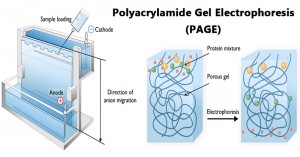What is polyacrylamide gel electrophoresis?
Polyacrylamide Gel Electrophoresis
Gel electrophoresis is a fundamental technique in laboratories across the biological disciplines, permitting the separation of macromolecules such as DNA, RNA and proteins. Different separation media and mechanisms allow subsets of these molecules to be separated more effectively by exploiting their physical characteristics. For proteins in particular, polyacrylamide gel electrophoresis (PAGE) is often the technique of choice.
PAGE is a technique that separates macromolecules such as proteins based on their electrophoretic mobility, that is, the ability of analytes to move towards an electrode of the opposite charge. In PAGE, this is determined by the charge, size (molecular weight) and shape of the molecule. Analytes move through pores formed in polyacrylamide gel. Unlike DNA and RNA, proteins vary in charge according to the amino acids incorporated, which can influence how they run. Amino acid strings may also form secondary structures that impact their apparent size and consequently how they are able to move through the pores. It may therefore sometimes be desirable to denature proteins prior to electrophoresis to linearize them if a more accurate estimate of size is required.
SDS PAGE
Sodium-dodecyl sulfate polyacrylamide gel electrophoresis is a technique used to separate protein molecules of masses 5 to 250 kDa. The proteins are separated solely on the basis of their molecular weight. Sodium dodecyl sulfate, an anionic surfactant, is added in the preparation of gels that masks the intrinsic charges of the protein samples and gives them a similar charge to mass ratio. In simple words, it denatures the proteins and gives them a negative charge.
Native PAGE
Native PAGE is a technique that uses non-denatured gels for the separation of proteins. Unlike SDS PAGE, no denaturing agent is added in the preparation of gels. As a result, the separation of proteins takes place on the basis of charge and size of the proteins. In this technique, the conformation, folding and amino acid chains of the proteins are the factors that the separation is dependent upon. The proteins are not damaged in this process, and can be recovered after the completion of separation.
How does polyacrylamide gel electrophoresis (PAGE) work?
The basic principle of PAGE is to separate analytes by passing them through the pores of a polyacrylamide gel using an electric current. To achieve this, an acrylamide–bisacrylamide mix is polymerized (polyacrylamide) by the addition of ammonium persulfate (APS). The reaction, which is catalyzed by tetramethylethylenediamine (TEMED), forms a net like structure with pores through which analytes can move (Figure 2). The higher the percentage of total acrylamide included in the gel, the smaller the pore size, hence the smaller the proteins that will be able to pass through. The ratio of acrylamide to bisacrylamide will also impact pore size but this is often kept constant. Smaller pore sizes also reduce the speed at which small proteins are able to move through the gel, improving their resolution and preventing them from running off into the buffer rapidly when current is applied.
Equipment for Polyacrylamide Gel Electrophoresis
Gel Electrophoresis Cell (Tank/Chamber)
The gel tank for polyacrylamide gel electrophoresis (PAGE) is different from the agarose gel tank. The agarose gel tank is horizontal, while the PAGE tank is vertical. By vertical electrophoresis cell (tank/chamber), a thin gel (normally 1.0mm or 1.5mm) is poured between two glass plates and mounted so that the bottom of the gel is submerged in buffer in one chamber and the top is submerged in buffer in another chamber. When current is applied, a small amount of buffer migrates through the gel from the top chamber to the bottom chamber. With strong clamps to guarantee the assembly stays in an upright position, the equipment facilitates fast gel runs with even cooling resulting in distinct bands.
Beijing Liuyi Biotechnology Co., Ltd. (Liuyi Biotechnology) manufactures a range of sizes of polyacrylamide gel electrophoresis cells (tanks/chambers). The models DYCZ-20C and DYCZ-20G are vertical electrophoresis cells (tanks/chambers) for DNA sequencing analysis. Some of the vertical electrophoresis cells (tanks/chambers) are compatible with blotting system, like the model DYCZ-24DN, DYCZ-25D and DYCZ-25E are compatible with Western Blotting system model DYCZ-40D, DYCZ-40G and DYCZ-40F, which are used for transferring the protein molecule from the gel to membrane. After SDS-PAGE electrophoresis, Western Blotting is a technique to detect a specific protein in a protein mixture. You can choose these blotting systems according to the experimental requirements.
Electrophoresis Power Supply
To provide the electricity for running the gel, you will need an electrophoresis power supply. At Liuyi Biotechnology we provide a range of electrophoresis power supplies for all applications. The model DYY-12 and DYY-12C with high stable voltage and current can meet high voltage requirement electrophoresis. It has the function of stand, timing, VH and step-by-step application. They are ideal for IEF and DNA sequencing electrophoresis application. For general protein and DNA electrophoresis application, we have the model DYY-2C, DYY-6C, DYY-10, and so on, which are also hot sales power supplies with electrophoresis cells (tanks/chambers). These can be used for the middle and low voltage electrophoresis applications, such as for school lab use, hospital lab and so on. More models for power supplies, please visit our website.
The Liuyi brand has more than a 50-year history in China and the company can provide stable and high-quality products all around the world. Through years’ development, it is worthy of your choice!
For more information about us, please contact us by email sales@ly.com.cn or sales01@ly.com.cn.
References for What is polyacrylamide gel electrophoresis?
1. Karen Steward PhD Polyacrylamide gel electrophoresis, How it Works, Technique Variants, and Its applications






